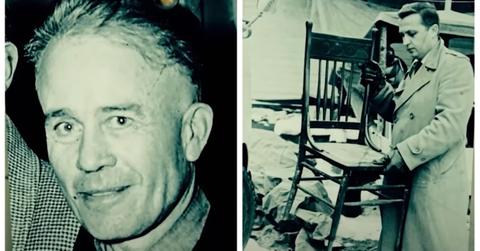Serial Killer Ed Gain Made Furniture out of Human Skin — What Happened to It?
Ed Gein made things out of the parts of women who reminded him of his mother.
Published Oct. 2 2025, 12:21 p.m. ET
To say that a serial killer like Ed Gein was complicated is quite the understatement. He was dubbed the Butcher of Plainfield due to the nature of the Wisconsin man's crimes. When Gein was arrested on the morning of Nov. 16, 1957, what police discovered shocked the small town of roughly 680 residents, per Time Magazine.
The body of 58-year-old Bernice Worden was found hanging by her ankles in Gein's kitchen. She had been gutted and dressed as if she was a deer that Gein shot while hunting. Worden's severed head was in a cardboard box while her heart was placed in a plastic bag, which was sitting on the stove. That was just the beginning, as authorities soon realized some of Gein's furniture had been fashioned out of human skin and other body parts. What happened to that furniture? Here's what we know.
What happened to Ed Gein's furniture?
Gein's trial was presided over by Judge Robert H. Gollmar, who wrote a book about the trial titled Edward Gein, America's Most Bizarre Murderer, which he published in 1981. According to Judge Gollmar, after the macabre artifacts found in Gein's house were photographed by police, they were properly disposed of.
Because Gein's crimes became a source of fascination for the residents of Plainfield and beyond, some of Gein's more questionable items that remained were plucked from the house before it burned down in what police believe was an act of arson. The Graveface Museum in Savannah, Ga., which has an exhibit dedicated to Gein, reportedly has a keychain the killer made from a lock of human hair.
Gein made a nipple belt, and a bunch of other disturbing things.
Upon searching Gein's house, police discovered the kinds of gruesome sights that would later inspire movies like The Texas Chainsaw Massacre and Silence of the Lambs. The 275-acre farm outside of Plainfield was the perfect place to hide two dead bodies and a host of items fashioned out of various body parts.
Investigators found "ten skins of human heads, neatly separated from the skull; assorted pieces of human skin, some between the pages of magazines, some made into small belts, some used to upholster chair seats (the largest piece, rolled up on the floor, was the front upper section of a woman’s torso); a box of noses," reported Time. The belts were made of human nipples.
While being interrogated, Gein also confessed to the murder of 54-year-old Mary Hogan, a tavern keeper who vanished in 1954. It was her face that Gein used to make a human mask. The killer insisted that the rest of the items were made from bodies he dug up from a nearby graveyard. Gein told police that he usually only took the heads and some other body parts. There was only one time he stole an entire female corpse.
Psychiatrists at the time noted Gein's obsession with his own mother, which manifested itself in both a deep love and intense hatred. They theorized that killing and digging up women who reminded him of his mother, then using their body parts, satisfied two urges. The first was his desire to destroy his mother. The other was his urge to resurrect Augusta Gein and keep her with him forever.

